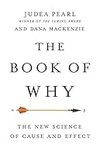
Saved by Ken Karakotsios and
The Book of Why

Saved by Ken Karakotsios and
instead of representing probability in huge tables, as was previously done, let’s represent it with a network of loosely coupled variables. If we only allow each variable to interact with a few neighboring variables, then we might overcome the computational hurdles that had caused other probabilists to stumble.
the effect of the do-operator is to erase all the arrows pointing to Fertilizer
“We think of a cause as something that makes a difference, and the difference it makes must be a difference from what would have happened without
The crux of the philosophical debate is whether we can legitimately translate the expression “given that I know” into the language of probabilities.
The process of looking only at rows in the table where Smoke = 1 is called conditioning on a variable.
To decide whether Exercise is beneficial or harmful, as always, we need to consult the story behind the data. The data show that older people in our population exercise more. Because it seems more likely that Age causes Exercise rather than vice versa, and since Age may have a causal effect on Cholesterol, we conclude that Age may be a confounder
... See more“Whenever you make an event happen,” we tell the computer, “remove all arrows that point to that event and continue the analysis by ordinary logic, as if the arrows had never been there.”
We can eliminate this spurious correlation, as Karl Pearson and George Udny Yule called it, by conditioning on the child’s age.
B C. This kind of junction is called a “fork,” and B is often called a common cause or confounder of A and C.